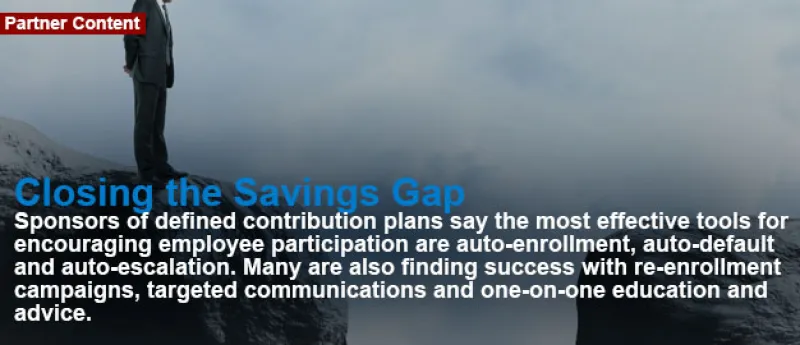In private-sector America, the responsibility to provide for retirement continues to shift from the employer to the individual. Yet, in an age of increasing lifespans and rising health care costs, many employees are woefully unprepared to manage their retirement savings or develop a saving strategy. Their employers are concerned: Our recent study of more than 500 sponsors of defined contribution plans with assets of $50 million above, in partnership with Prudential, found almost half of plan sponsors reporting that their participants fail to make the maximum contribution, while more than one third said most of their workforce do not participate in the plan at all.
To help overcome employees’ inertia and place them on a path to accumulating the resources they will need to retire, DC plan sponsors are leveraging three key automatic features:
- Auto-enrollment. Employees are automatically enrolled into the plan, usually at hire, at a set percentage rate and with the option to opt out.
- Auto-default. As part of auto-enrollment, participants are automatically defaulted into a qualified default investment alternative (QDIA) — increasingly, a target date fund — with the option to instead select their own investments within the plan.
- Auto-escalation. Once in the plan, participants’ deferral percentages are automatically increased in small increments over time, as long as they choose to continue or until they reach the maximum set rate.
Auto-enrollment is critical to helping employees, says Clint Barker, senior vice president of retirement investment solutions at Prudential Investments: “When you combine that with auto-escalation, they may not start at the right contribution rate in the beginning, but by auto-escalating them each year, you continue to help them toward their goal.”
It’s important to align auto features with the employer’s goals and objectives and workforce demographics, however. “Employers looking at auto features need to consider a couple of things,” says Robyn Credico, defined contribution consulting leader at Willis Towers Watson. “First, how much do I default the person, and what kind of default is it going to be? Second, should it be pretax or should it be Roth? We have seen some very large employers actually now default their employees into Roth 401(k)s because ultimately it improves their retirement readiness.”
At distiller Brown-Forman Corp., which sponsors corporate and union plans with a collective $448 million in assets, “we have chosen to auto-enroll at 5 percent, which is where our match is,” says Donna Wimbec, senior manager of global benefits compliance. “We allow folks also to go in and auto-escalate on their own. We don't have a mandatory auto-escalation program, but an employee can go into auto-escalate and they can set that number as high as they want.”
Yet even employers that have improved participation and are watching employees escalate their contributions year after year may not see them accrue enough to retire comfortably, because either escalation is still not as steep as needed, the employer match is too small, certain demographics are harder to reach, or some combination of factors. Numerous recent studies have shown that in order to accumulate enough money to achieve a secure retirement, the average plan participant needs to contribute between 12 and 15 percent of annual salary — but the average participant contribution rate is between 5 and 7 percent.1
“I would argue there's more work to be done,” says Michael Domingos, vice president of national corporate distribution and strategy at Prudential Retirement. “We would actually advocate for higher initial automatic enrollment and increasing up to and through 15 percent, understanding that there are clearly considerations from a cost and budget perspective to organizations.”
Another way to increase participation and close the gap in saving rates is to conduct reenrollment campaigns for all eligible employees. “For those who haven't been auto-enrolling in the past,” says Credico, “we recommend to reenroll every single year, or at a minimum re-auto-increase every single year.”
At International Paper, “we do reenrollment programs, and they have been very successful,” says Hunkeler. “I think oftentimes we are the ones who resist it the most by being concerned that our participants will object to these types of programs. We have found through practice that that's not the case. Usually, we get very high acceptance rates, with very little pushback. We are fans of reenrollments.”
Targeted communication in traditional and digital forms as well as one-on-one education and advice remain essential to effectively conveying the benefits of saving early and often, especially for employees with less financial education. More than half of plan sponsors in our study said retirement planning tools are very effective at helping mitigate risks to employees’ retirement security, while 62 percent said personal advice on asset allocation and financial planning is one of the most effective tools for boosting savings and improving investment outcomes.
More plan sponsors are leveraging plan education, financial wellness programs, and advice and technology to help make the difference. “From an education perspective, I think you're only going to see more tools roll out,” says Domingos. “We welcome that, and we're actually very active in some of those discussions and finding new technologies as well. We do think that it's the blending of those two — having the right digital platform and having the right individual coaching when the employee needs it most — that's going to make the difference.”
1 Prudential, Overcoming Participant Inertia: Automatic Features That Improve Outcomes While Improving Your Plan’s Bottom Line, 2015.
ABOUT THE SURVEY
This study was developed by Institutional Investor, in partnership with Prudential, to identify the investment risks and behavioral challenges that need to be addressed throughout the retirement planning process and how plan sponsors, advisers and consultants are trying to overcome them.
To support this research, a survey was distributed to Institutional Investor's audience of plan sponsors as well as advisers and consultants between January and February 2016. We received 511 completed survey responses from the plan sponsor audience and 295 completed survey responses from advisers and consultants.
Auto-enrollment: An automatic contribution arrangement that can be used as a feature in a retirement plan to allow employers to enroll employees in the company’s plan automatically upon meeting eligibility requirements.
Auto-escalation: A plan design option that allows a plan sponsor to increase participant deferrals annually by a set increment.
These materials are for informational or educational purposes only. The information is not intended as investment advice and is not a recommendation about managing or investing your retirement savings. In providing these materials Prudential Investments is not acting as your fiduciary as defined by the Department of Labor.
Investing involves risks. Some investments have more risk than others. The investment return and principal value will fluctuate and the investment, when sold, may be worth more or less than the original cost and it is possible to lose money. Past performance is not a guarantee of future results. Asset allocation and diversification do not assure a profit or protect against loss in declining markets.
© Prudential Financial, Inc. and its related entities. Prudential, and the Prudential logo, the Rock symbol, and Bring Your Challenges are service marks of Prudential Financial, Inc., and its related entities, registered in many jurisdictions worldwide.
0299634-00001-00






